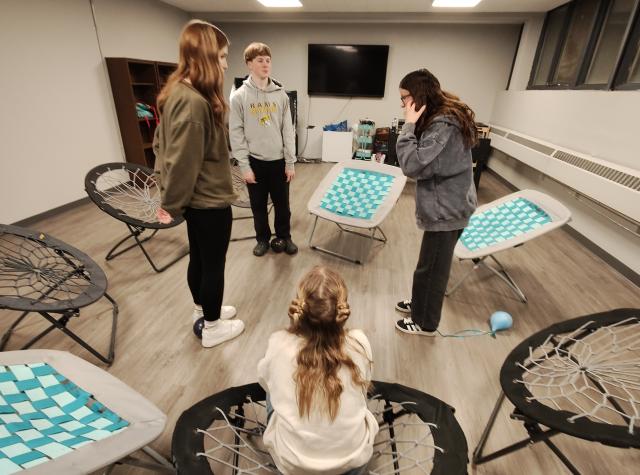Baz Skinner shares what she’s learned about how to truly welcome youth as valuable members within our communities of faith.

One of the number one things I hear in rural youth ministry is, “We don’t have any youth.” I always add, “In your pews!” When you take a moment and really consider if there are youth in your community, suddenly names pop into mind… “Oh, well, there’s Sam who helps at the barn on the weekend, and their sister… what’s her name again?” It’s easy to forget about youth, especially since COVID; screen times have become more normalized, they’re often hiding inside and making connections digitally.
While sometimes I struggle to get youth to attend activities, I rarely struggle to find youth volunteers when the church needs them. Whether that be for dishes, room setups, or moving furniture—suddenly I have more hands than I know what do with. As First Third Animator in southwestern Alberta, a common struggle I’m finding isn’t youth attending things (including Sunday worship), it’s parents getting them there. Routinely teens will be at church texting other teens, and I’ll ask, “Is Ben coming?” and I’m surprised how often the answer is that “he can’t get a ride.”
Another common misconception is that youth groups need to have a gimmick: “Come join us and you could win an iPad!” “Come to our youth group, we do all this cool stuff!” I promise you, it’s not necessary. A few weeks ago, I had a stack of paper cups and said, “Let’s see who can keep a cup on their head the longest” and they played that for 45 minutes! The next month, they wanted to play again.
Some days I have 17 youth, and others only four. We’ll sit around a table and play cards, and every single time they’ll start to talk about what’s going on with them. Recently, my group was talking about how weird it is to have lockdowns in their classrooms in preparation for shooters. “They tell us to lock down, we’re huddled in the dark in a classroom, and then it’s all over and we have to sit in chairs that just blocked the door and do a social studies test. It’s weird.” Yeah. You’re right! That is weird! Let’s unpack that. Let’s talk about how God can be turned to in those moments. Let’s talk about prayer.
With the constant movement in teens’ lives these days—TikToks gone in seconds, newsfeeds changing all the time—we need to remember that sitting in a church pew for an hour is actually uncomfortable for some teens. That’s not the culture they live in. While some may enjoy quiet reflection, others find it stressful, boring or uninteresting…. and that’s OK! We need to remember church doesn’t just happen on Sundays in a sanctuary. Perhaps one of the greatest things congregations can offer to youth is simply a free place to exist. It’s incredibly powerful to witness a congregation realize their church building also belongs to its youth. Church is also a place where there’s no cost to gather, which is a huge selling feature for teens.

I appreciate that for churches, it’s hard to take these risks, and the rewards aren’t always immediate. Perhaps adults have an idea of what they want youth ministry to look like, and that might not be the same thing the youth in your community want. I’ve learned in my time working with youth to let them tell you what they need. Listen to their experiences, and let the spirit guide your response to what you learn.
This doesn’t need to start with a big official youth programming launch, it can be something very small and casual: “Want a place to hang out after school? We don’t have the best Wi-Fi, but the couches are comfortable and it’s warm. Just know it’s an option. Tell your friends. If you ever need a place to hang out that isn’t someone’s house, you can use this space.”
When one of my groups realized our youth room belonged to them, it opened all sorts of doors. “Can we paint a mural?” “Can we fundraise for a sound system?” “Can you come tell my class about this, so they’ll come, too?” One church gave the youth a recurring gym time to play pickleball, and they’ve already challenged the adult group after them to a tournament! Of course, they need to learn the game first.
Youth are connected to huge communities through social media and online platforms. They’re skilled at making connections where we adults may feel intimidated. Interfaith and ecumenical ways of life are natural traits of youth. When used safely, social media is a fantastic tool for teens to learn about diversity and differences. Youth can find anything online these days, but what churches can provide is something incredibly unique: a place of deep and radical love. One that notices when someone isn’t there, one that can travel with them if their circumstances change, and one that is so powerful it can only be understood through experience.
—Baz Skinner is a First Third Ministry Animator for communities of faith in southwestern Alberta.
The views contained within these blogs are personal and do not necessarily reflect those of The United Church of Canada.